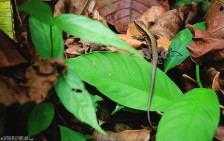Rambling thru a jungle safari at Manuel Antonio, Costa Rica
May 2015
 The day after our passage from Bahia Ballena was our last full one with Mark and Helen. We awakened early and peeled ourselves from the relative coolness (low 80s Fahrenheit) of the cabin and then emerged from our fiberglass lair.
The day after our passage from Bahia Ballena was our last full one with Mark and Helen. We awakened early and peeled ourselves from the relative coolness (low 80s Fahrenheit) of the cabin and then emerged from our fiberglass lair.
Together, we savored fancy coffee and a delicious breakfast at Mercado del Porto, before walking 10 minutes to the bus station. We rode a bus 20 minutes up the twisty, winding hill to the town of Manuel Antonio. Each curve yielded new and beautiful ocean vistas, an interesting restaurant, or verdant hillside. When we arrived in Manuel Antonio, both sides of the narrow road were lined with peddlers selling colorful wares and coconuts and offering their services as a guide through Manuel Antonio Nacional Parque, our destination du jour.
When we arrived in Manuel Antonio, both sides of the narrow road were lined with peddlers selling colorful wares and coconuts and offering their services as a guide through Manuel Antonio Nacional Parque, our destination du jour.
 The Costa Rica you see on postcards
The Costa Rica you see on postcards
Manuel Antonio boasts such richness in biodiversity that a place comparable would be difficult to find almost anywhere else in the world, especially given its compactness. At roughly twice the size of Central Park in New York City, Costa Rica’s smallest national park contains every manner of natural delight you can imagine: lush tropical forests, white sand beaches, and tropical creatures galore! Manuel Antonio is a haven for more than 100 species of mammals and nearly 200 types of birds. I find it hard to imagine that any visitor would not find the park absolutely enthralling! All of the trails can be walked in a solid half day, and there are ample opportunities to sit down and rest, as needed.
I’ll let our photos speak for themselves, but within the marvelous tropical paradise, we saw Hoffmann’s two-toed sloths, brown-throated three-toed sloths, howler monkeys, endangered squirrel monkeys (known as “titis”), capuchin monkeys, iguanas, tiny green lizards, Halloween crabs, hermit crabs, variegated squirrels, raccoons, a morpho butterfly, a common potoo (which are difficult to spot in daytime because they look like a sawed-off tree branch), a host of other birds whose names we know not, and a portly sea lion. Impressive, to say the least!
A vacation recommendation
If you are planning a vacation to Costa Rica, please consider traveling to Quepos and Manuel Antonio Parque Nacional! By our standards, the park entrance fee is a bit steep ($15USD per person), but that is simply because we must be penny pinchers when we don’t have a steady stream of income trickling into our bank accounts. That said, the experience is worth every penny! The opportunity to see a rare species of monkey and two types of sloths traipsing about in the wild, in particular, made the experience truly priceless.
In addition, there are lodging options for every budget, from hostels to VRBO-style rentals to five-star luxury hotels. There are also clever restaurants, including one that is situated in an old C-123 Fairchild cargo plane atop a cliff, and a fantastic farmers market each Friday and Saturday along the beach promenade. It is truly a lovely place. Tips for your visit
Tips for your visit
- Arrive as early in the morning as you possibly can. The animals are most active in the morning and evening when the heat is not so brutal. We arrived at around 10:30 am. We saw loads of critters, but getting there an hour or two earlier would have made our visit more comfortable. We also didn’t see any frogs…perhaps if we would had begun exploring earlier in the morning a few would have been hopping around the jungle floor.
- Bring your camera and your best zoom lens. I’m quite pleased with our photos, but I think our shots would have been all the more compelling had I been able to zoom closer, rather than crop in.
- If you have the time, be prepared to stay all day. If we were to do it all again, we would hike during the early morning, relax on the beaches midday, and then wind our way back through the trails to exit in the late afternoon. The beaches are gorgeous and there are seaside rock formations to be explored. Sometimes monkeys play on the sand (don’t leave your bags or food unattended!) and hermit crabs scamper about, as do large iguanas.
- Consider paying for a guide. We did not pay for a guide, but we learned some fun tidbits by casually standing near a tourist and her guide for a few minutes. When Neil spotted a sloth and pointed it out to the nearby guide, he invited us along for part of their walk and shared a few tidbits back with us, quid pro quo. If you are looking for an educational experience in addition to National Geographic-style animal sightings, this would be a worthy investment (especially if you have kids in tow and are “boat schooling”). Speak to a few guides outside the park before selecting one, and be sure to pick one who is toting a telescope!



























Great Post
LikeLiked by 1 person
Thanks, Mukul!
LikeLiked by 1 person
Love it
Sent from my iPhone
LikeLiked by 1 person
Thanks for catching us all up with your adventures Jesse! Great tips in the last couple of posts and as always, your photos are full of life! Excited for you guys knowing you are down there working on your boat, readying her for another launch! Hugs from the NW and Go Hawks! Hope you can watch the game today. 🙂
LikeLiked by 1 person
Thank you – thank you…and YES, we found a bar here that was showing the game, and what a game it was! GO HAWKS! ~Jessie & Neil
LikeLike
Pingback: Voyage stats: Our months FOUR thru EIGHT | s/v The Red Thread
Pingback: Voyage stats: Months FOUR thru EIGHT | s/v The Red Thread
Pingback: Three sparrows, one family, and a dog with a phantom pregnancy | s/v The Red Thread